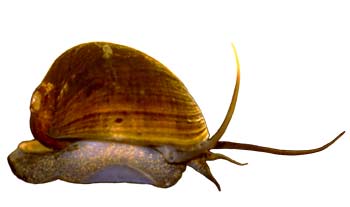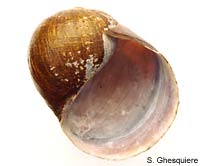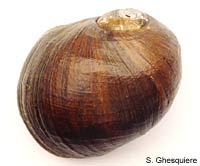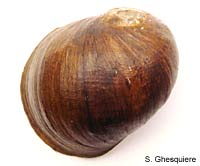
(Sowerby, 1825)
 |
(Sowerby, 1825)
|
 |
 |
 Asolene (Pomella) megastoma. Uruguay River, São Borja city, Rio Grande do Sul, Brasil. 25-01-2000. 77 mm high. |
 Asolene (Pomella) megastoma. Uruguay River, São Borja city, Rio Grande do Sul, Brasil. 25-01-2000. 73 mm high. |
Shell: Very large shell (up to 100mm
height), as wide as high with a very large mouth, even larger than the body
whorl. The spire is depressed and nearly invisible from the front In largers
shells, the spire can be heavily erroded.
The shell is relatively thick and heavy, although it might look fragile at first.
The surface is rough and the umbilicus is very narrow to closed.
The colour varies from green to light brown without or only with a very faint
banding pattern. The shell is white, with a faint violet at the inside.
|
Interactive 3D-models (Java): |
Operculum: The operculum is moderately thick and corneous. The structure
is concentric with the nucleus close the centre of the shell. The colour is
dark brown to black. The operculum can be retracted in the aperture (shell opening).
 |
 |
 Asolene (Pomella) megastoma. |
 Asolene (Pomella) megastoma. |
Body: Brown to nearly black with yellow spots on the back of the foot
and around the head.
The head is relatively broad (the eyes and the tentacles are far apart) and
the tentacles are of medium length and are quite thick. The eyes are rather
small comared with other Ampullarids.
Eggs: The eggs are laid out of the water in a pinkish calcareous mass
attached on vegetation or rocks. (observed by: Fabio Faraco, Brasil and Manuel
G. Quintana, Argentina).
Behaviour: Asolene megastoma mainly resides on the bottom and
in shadow rich places of its habitat. The shell is kept close to the ground
and due to its flat shell shape and its large foot, it's hard to remove the
snail from a solid surface. Not surprisingly for a snail that lives in rivers
and streams with strong currents at times.
The broad head, with the eyes and tentacles on the outher ends, enables the
snail to keep the eyes out of the shell, while the shell border touches the
surface in front of the snail.
Distribution: Southeastern of Brasil: the Rio Uruguay system.
With thanks to Fabio Faraco for providing the shells which are displayed on this page.
|
Except where otherwise noted, this page is licensed under a Creative Commons Attribution-NonCommercial-ShareAlike 2.5 License . http://www.applesnail.net |
|